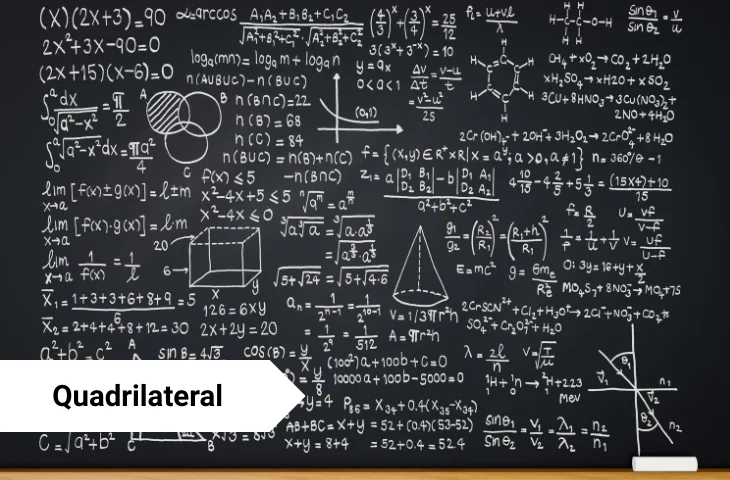In Quantitative Aptitude, Quadrilateral is an important Geometry topic that often appears in SSC, Banking, and Railway exams. In this blog, we have provided all the details about quadrilateral from definition, formulas, types, tricks, solved examples, and more.
What Is Quadrilateral in Quantitative Aptitude?
A Quadrilateral is a closed polygon with four sides, four vertices, and four angles.
It is a fundamental concept in Geometry and forms the base for related shapes like squares, rectangles, parallelograms, rhombuses, and trapeziums.
Why it appears in exams:
- Tests basic geometry knowledge.
- Requires understanding of properties, types, and formulas for perimeter & area.
Skills required:
- Visualization of shapes
- Formula application
- Logical classification of figures
Why Is Quadrilateral Important in Competitive Exams?
Quadrilateral questions are high-scoring as they have direct formulas and properties. They appear frequently in SSC, Banking, and Railway exams.
| Exam | No. of Questions | Difficulty |
| SSC CGL / CHSL | 1–2 | Easy |
| IBPS PO / SBI PO | 1–2 | Moderate |
| RRB NTPC / Group D | 1 | Easy |
| State PSC / Police | 1–2 | Moderate |
Quadrilateral Quantitative Aptitude Short Notes
Terms used to solve questions based on the topic of quadrilaterals are as follows:
| Term | Details |
| Sides | 4 straight lines forming a closed figure |
| Sum of interior angles | Always 360° |
| Types | Square, Rectangle, Parallelogram, Rhombus, Trapezium, Kite |
| Diagonals | Line segments joining opposite vertices |
| Convex quadrilateral | All interior angles < 180° |
| Concave quadrilateral | At least one interior angle > 180° |
Quadrilateral Concepts
Concepts used to solve questions based on quadrilaterals are as follows:
| Concept | Details |
| Interior Angle Sum | 360° for all quadrilaterals |
| Perimeter | Sum of all sides |
| Area of rectangle | Length × Breadth |
| Area of square | Side² |
| Area of parallelogram | Base × Height |
| Area of trapezium | ½ × (Sum of parallel sides) × Height |
What Are the Types of Quadrilateral Questions in Quantitative Aptitude?
In exams, quadrilateral problems can be:
- Direct: Formula-based perimeter/area questions.
- Property-based: Identifying shape based on given properties.
- Mixed-concept: Quadrilateral inside other figures.
- Diagram-based: Finding missing side/angle using geometry rules.
Quadrilateral Formulas for Quantitative Aptitude
Formulas related to the quadrilateral are as follows:

Quadrilateral Tricks for SSC CGL and Other Exams
Tricks to solve questions based on quadrilateral are as follows:
- Always check if given shape is a special quadrilateral it may simplify the formula.
- Remember: All squares are rectangles, but not all rectangles are squares.
- Use Pythagoras theorem for diagonals in right-angled quadrilaterals.
- If a quadrilateral is cyclic, opposite angles sum to 180°.
- For composite figures, split into known shapes.
Solved Quadrilateral Questions from 2024–25 Exams

Common Mistakes to Avoid while Solving Quadrilateral
Common mistakes to avoid while solving questions based on quadrilaterals are as follows:
- Confusing trapezium with parallelogram.
- Forgetting that sum of angles is always 360°.
- Misusing Pythagoras theorem in non-right-angled cases.
- Mixing diagonal formulas of square & rectangle.
- Ignoring unit conversions.
FAQs
Memorize basic formulas and identify the shape type quickly.
Rectangle and Square.
Sum of all four sides.
Yes, often in combination with mensuration and data interpretation.
Split into triangles or other shapes, then sum their areas.
- PNB LBO Syllabus and Exam Pattern 2025, Check Details
- PNB LBO Salary 2025, Pay Scale, Perks and Benefits
- SBI CBO Final Result 2025 Out, Download Final Selection PDF
- IBPS RRB PO Exam Analysis 2025, All Day, All Shifts
- 100 Shortcut & Trick Questions Compilation for SSC CHSL
- Most Repeated English Questions for SSC CHSL Tier 2

Hi, I’m Aditi. I work as a Content Writer at Oliveboard, where I have been simplifying exam-related content for the past 4 years. I create clear and easy-to-understand guides for JAIIB, CAIIB, and UGC exams. My work includes breaking down notifications, admit cards, and exam updates, as well as preparing study plans and subject-wise strategies.
My goal is to support working professionals in managing their exam preparation alongside a full-time job and to help them achieve career growth.
